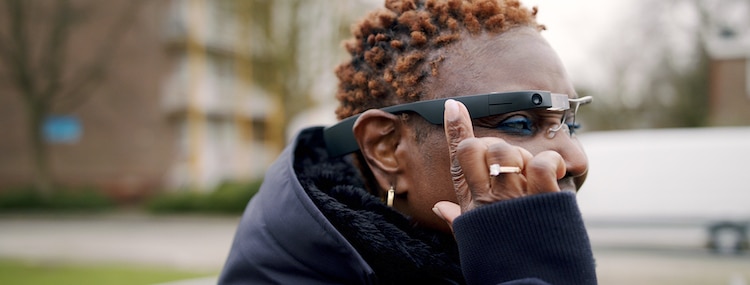Mobility Aids for Visually Impaired Users: Enhancing Independence and Navigation
Discover Advanced Assistive Instruments for People With Visual Impairments
The landscape of assistive innovation for individuals with visual problems is evolving quickly, providing a variety of cutting-edge gadgets that enhance autonomy and engagement. From wise glasses that flawlessly merge aesthetic input with acoustic guidance to innovative navigating applications that redefine spatial awareness, these devices are improving possibilities.
Smart Glasses Innovations
Smart glasses represent a significant advancement in assistive technology for people with aesthetic impairments. Equipped with electronic cameras and sensing units, clever glasses can capture real-time aesthetic details, which is after that processed and conveyed to the individual through sound comments or haptic sensations.
In addition, innovations in fabricated intelligence have further improved the abilities of wise glasses. Artificial intelligence algorithms can recognize faces, checked out message, and determine things, making them very useful tools for day-to-day tasks. Customers can obtain acoustic signs that give context about their environment, fostering self-reliance and self-confidence.
Additionally, the ergonomic layout and lightweight nature of many clever glasses make them appropriate for long term usage, making sure comfort while improving functionality. As these devices continue to advance, they hold the potential to reinvent the way individuals with visual problems experience their day-to-days live, bridging the void between accessibility and technology. The ongoing r & d in this area assurance to increase the opportunities for smart glasses, making them a necessary element of contemporary assistive tools.
Navigation Apps and Equipment
Many navigating applications and devices have emerged as important sources for individuals with aesthetic impairments, dramatically improving their ability to traverse strange environments. These innovations leverage general practitioner capability, audio cues, and real-time information to offer customers with precise navigating help.
One popular instance is the Aira application, which connects users to experienced agents who can offer aesthetic descriptions of environments and navigating guidance through a real-time video feed. This solution boosts the customer's spatial understanding and confidence while navigating. Another significant tool is Seeing Eye GPS, which supplies voice-guided navigating and sights, allowing customers to accessibility vital information about their environments.

As modern technology remains to advancement, the development of a lot more sophisticated navigation tools guarantees to more empower people with visual impairments, assisting in seamless movement and integration right into varied settings. Such innovations are crucial in advertising a much more inclusive society.
Braille Innovation Innovations
Over the last few years, improvements in Braille innovation have actually dramatically transformed how individuals with aesthetic impairments gain access to information and engage with the world around them. The development of portable Braille display screens has actually revolutionized analysis by enabling users to link wirelessly to mobile phones, tablet computers, and computers. These devices convert message right into Braille in real-time, making it possible for smooth interaction with electronic material.
Moreover, ingenious Braille printers have arised, boosting the manufacturing of responsive materials. Modern embossers are quicker and more effective, enabling the rapid creation of Braille documents and educational products. This efficiency lowers the moment and price connected with creating Braille sources, making them a lot more easily accessible to colleges and organizations.
Furthermore, the assimilation of Braille with other technologies, such as fabricated intelligence and maker knowing, has actually opened new opportunities for customized learning experiences. Voice recognition and synthesis modern technologies can match Braille, supplying an inclusive method to info dissemination.
As the demand for inclusive education and work environment settings grows, these technical advancements play a vital role in equipping people with aesthetic disabilities, guaranteeing they have equal accessibility to info and possibilities in numerous aspects of life.
Wearable Devices for Freedom
An expanding range of wearable gadgets is improving freedom for individuals with aesthetic problems, providing cutting-edge options that enhance navigation and everyday living. Braille displays and notetakers. These tools utilize advanced technologies to supply real-time comments and assistance, promoting autonomy in various atmospheres

Wearable innovation likewise includes smartwatches that can be configured with access features, enabling users to receive notifications, track their areas, or even call for aid with the touch of a switch. Moreover, some devices incorporate expert system to evaluate the environment, offering audio summaries of nearby items or people.
Voice-Activated Assistive Solutions
Leveraging voice-activated assistive options has actually changed the family optometry landscape of assistance for individuals with visual impairments, providing hands-free communication and accessibility to a range of tasks. These technologies make use of all-natural language processing and expert system to allow individuals to do day-to-day tasks through easy voice commands.

Additionally, recent advancements in voice acknowledgment accuracy have actually enhanced the customer experience dramatically, accommodating varied accents and speech patterns. This inclusivity guarantees that even more individuals can profit from these technologies, cultivating a higher feeling of autonomy.
Conclusion
Finally, the development of sophisticated assistive devices substantially boosts the self-reliance and lifestyle for individuals with visual problems. Developments such as clever glasses, navigation apps, Braille modern technology, wearable devices, and voice-activated Full Report options jointly foster a more comprehensive setting. These technologies equip individuals to browse their surroundings with confidence and involve even more fully with the world, ultimately promoting better ease of access and level playing fields for people encountering aesthetic challenges.
The landscape of assistive innovation for individuals with aesthetic problems is advancing rapidly, offering an array of ingenious tools that enhance freedom and involvement.Smart glasses represent a considerable innovation in assistive technology for individuals with aesthetic problems. As these tools proceed to advance, they hold the possible to change the means people with aesthetic impairments experience their everyday lives, connecting the space hop over to these guys between ease of access and innovation.In recent years, improvements in Braille modern technology have actually significantly changed how individuals with aesthetic problems accessibility details and involve with the world around them. These innovations equip users to navigate their environments with self-confidence and engage more totally with the globe, eventually advertising better availability and equal opportunities for people encountering visual challenges.